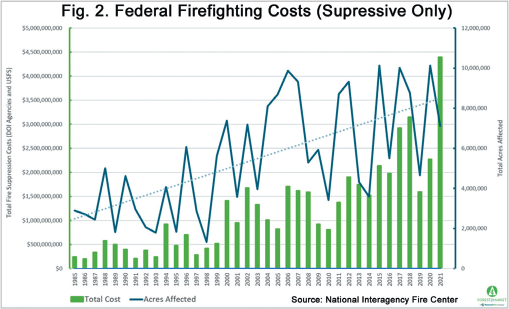The paper and packaging industry has made considerable progress in developing ongoing contributions that have helped redirect the growth of the forest products industry toward a more sustainable future as ESG (Environmental, Social, and Governance) issues have become top-of-mind for both corporations and consumers. However, the industry’s sustainability evolution doesn’t simply begin and end within individual end-product sectors. It extends upstream from the manufacturing process and branches in various directions. These can include several legs of transportation, raw materials production, engineering, and, most importantly for forest health, wood fiber sustainability.
While sustainable forest management has gotten more airtime in recent years than it did decades ago, anti-forestry extremists continue to double down on a rejection of reason while embracing what can best be described as a form of anti-scientific “insanity.” As a result, they continue to put America’s forests, wildlife, rural communities, and natural resources at risk.

One recent example comes from 1960s icon and singer/songwriter Carole King, who leveraged her celebrity status to publish an opinion piece in the New York Times titled “It Costs Nothing to Leave Our Trees as They Are,” which called for an end to commercial timber harvesting on federal lands. “President Biden should issue an executive order immediately directing his secretaries of the interior and agriculture to take all steps available to them to stop commercial logging on public land,” King wrote. She goes on to promote many of the stale, dated arguments that were believed to be relevant decades ago.
As Nick Smith, executive director at Healthy Forests, Healthy Communities observed, “It’s unclear what makes her an expert on forestry, other than the fact she lives luxuriously in Idaho, in a house made of wood, with a national forest as her ‘nearest neighbor.’”
Even cursory research around King’s primary point of contention illustrates that most federal forestland is already off-limits to commercial timber harvesting. At one time, nearly one-fourth of all new US homes were built with lumber harvested from national forest trees. Now, it’s close to zero—where it has been for the last 20+ years. Figure 1 illustrates the drop in cut volume.
King then recites a few reactionary and simplistic anti-forestry talking points: “Trees absorb carbon dioxide and water from the air and ground and through the process of photosynthesis release oxygen into the air. It costs nothing to leave them as they are. Allowing commercial logging to continue in our national forests would also be a catastrophe for the biodiversity they contain. The order I propose would bring about a significant reduction in atmospheric carbon dioxide. And it will help the United States meet the requirements of the Paris agreement, which Mr. Biden rejoined on the first day of his presidency.”
King’s flawed logic, unfamiliarity with the simple lifecycle science of how trees grow and die, and unwillingness to entertain reason may be the norm for many celebrities, but environmental scientists and those dedicated to improving forest health know the opposite is true: There is a tremendous cost to leaving our trees alone.
THE REAL COST
Without proper management that includes thinning and harvesting, forests become overstocked and subject to pest and disease invasions that can quickly convert once-healthy timber stands into millions of acres of dead and decaying trees. This buildup of dead trees then becomes dangerous fuel for megafires, which release carbon emissions that affect everything from regional forests to the global climate. They also drive climate change-related events that then contribute to even more wildfires.
Since the adoption of the Clinton-era Roadless Rule, 37 million acres of national forests have burned, destroying families, forests, and communities while emitting billions of tons of carbon dioxide and other harmful pollutants into the atmosphere. For example:
- The 2018 “Camp Fire” that scorched the Sierra Nevada, CA, foothills killed 85 people, destroyed nearly 19,000 homes and other buildings, and effectively leveled the town of Paradise.
- California wildfires in 2018 resulted in US$7.8 billion in estimated health costs in the Bay Area alone, increased hospital admissions, and increased air pollution.
Beyond the destruction of lives, communities, and natural resources, the annual monetary costs expended by the federal government solely on fire suppression are simply unsustainable. The patterns in Figure 2 clearly illustrate that the disastrous anti-forestry policies instituted in the mid-1980s have resulted in more acres affected by wildfire at ever-expanding costs to taxpayers.

Per the National Association of State Foresters, Western fire seasons now last 78 days longer on average than they did in the 1970s, and fires are projected to grow hotter, more unpredictable, and more expensive. Beginning in 2020, US$2.25 billion was made available to the USDA for wildfire suppression and the Department of the Interior. This budget authority will increase by US$100 million each year, ending at US$2.95 billion in 2027.
And what about the environmental costs exacted by these fires?
In 2020, nearly 11 million acres of forests burned in the Western US at tremendous social and financial costs. To put the carbon emissions from these events into perspective, the 2020 wildfires in California alone generated nearly 100 million metric tons of carbon dioxide emissions, which is roughly 30 million tons more CO2 than the state emits annually from power production. That number is also equal to half of the total carbon stored in the forests of Humboldt County, CA, which are densely populated with enormous sequoias.
ENOUGH ANTI-FORESTRY INSANITY
The bottom line is this: America’s federal forests are choked with an overgrowth of dead and dying trees, which act as dangerous wildfire fuel while reducing their ability to sequester carbon. We have been following the same faulty protocols for decades while expecting a different result. And yet, the data are incontrovertible. Trees are dying in our national forests at ever-increasing rates, tree growth is down by more than 50 percent, and harvests are down by 80 percent (see Figure 3). Does anyone honestly believe this is a practical, sustainable solution for managing our forest resources?
Obviously, no one is “winning” in this situation—not the rural communities and wildlife habitats in the West; not the millions of outdoor recreationists; not the forest products and pulp and paper industries, or the logging sector; and especially not the regional forests and surrounding environment.

We must change course. Throughout the Western US, scientists are warning that we must cut tree densities to sustainable levels to allow forests to become more fire resilient. Commercial thinning and logging are tools that help sustainably accomplish this work while improving forest health and providing the wood-based products that keep the paper and packaging industry running—clearly a “win-win” for our industry and the environment.
According to The Paper and Packaging Board, several paper companies are already committed to local landowners and forests that provide a natural, renewable, and non-fossil-fuel wood resource that can “live many lives” through a widely available recycling infrastructure.
We’re now seeing many paper companies work hand-in-hand with mostly private landowners, both individuals and families, to grow more trees faster than they are being harvested. And increasingly, forests are being certified by independent organizations that ensure important ecosystem components like soil, water, and wildlife are considered in standard management practices.
While we know paper plays a major role in resolving global plastic pollution issues, we must remain mindful of our natural resources and the interconnected web of multiple industries that play a vital role in the production of pulp and paper. There remains a large gap between our aspirations and reality—and closing that gap is going to take education, research, and effective tools companies can use to accurately measure their environmental impacts.
As consumers increasingly seek out companies that understand the alignment between personal value systems and purchases—especially younger generations, who represent the first cohorts with considerable purchasing power in history to make decisions based on environmental factors—pulp, paper, and wood products manufacturers, as well as forest managers, loggers, and all participants up and down the value chain, need to take an active role in advocating for the important work we all do. Our work helps deliver the sustainable products we all depend on every day while keeping America’s forestlands healthy and vibrant so that they can continue to provide a precious renewable resource for future generations.
 Paper 360
Paper 360

